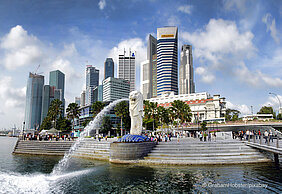The cooperation between the Singapore National Water Agency PUB and TZW lasts since June 2014 with several projects being worked on. The research project completed in 2019 was aimed to evaluate the Laser-Induced Breakdown-Detection (LIBD) as a monitoring tool for the integrity of reverse osmosis membranes with regard to the removal of nanoparticles in the size range of viruses.
The LIBD is one of the most sensitive methods (based on laser induced breakdown detection) to detect nanoparticles in diluted water solutions. Tests with a LIBD prototype device were carried out at one of PUB’s NEWater factories in Singapore for the determination of the possible application of this method for monitoring the RO process.
During two field trips the LIBD was operated onsite to carry out two types of measurements in the feed and the permeate of the RO process at Kranji NEWater factory:
- S-curve-measurements with increasing laser pulse energy level to determine nanoparticle size distributions
- Online-monitoring measurements with constant laser pulse energy to determine fluctuations of permeate quality
S-curves showed that RO permeate is of very good quality and contains only very low concentrations of nanoparticles. During the online measurements it was possible to determine the baseline of the permeate quality.
In order to check if LIBD is able to detect viruses of the defined size range (20 nm - 30 nm) in the permeate two spiking tests at the RO pilot plant were carried out during which LIBD and phages were measured in the permeate in parallel.
LIBD signal showed no change during the spiking. This is either due to the fact, that the RO membranes were intact and no phages could pass, or that the concentration of the phages in the permeate was too small to be detected by the LIBD.
From calibration measurements with polystyrene nanoparticles of 20 nm, 30 nm and 50 nm particle size and different concentrations it can be derived, that the lowest concentration that could be significantly detected by LIBD was around 10 ng/L (= 2x106 particles per mL) of 20 nm nanoparticles. Lower concentrations cannot be detected and are therefore detection limit of the LIBD.
Conclusively, LIBD cannot detect phages at low concentration conditions, such as when there is a breakthrough in the RO process.
Although LIBD is not suitable to give LRVs for nanoparticles it still can be used as an online monitoring supplement parameter for the permeate quality. The results of the operational monitoring showed that fluctuations could be detected depending on changes in the operation conditions. As there is no correlation between LIBD signal and the other online parameters like TOC or conductivity, LIBD can be an additional monitoring parameter.
To implement LIBD in the process some development work has to be done to tackle the problem of the device with the challenging onsite conditions (30°C and high air humidity).
The recommendation of TZW for achieving the aim of a monitoring tool, which can deliver LRV for the RO process with regard to nanoparticles is only to use other methods in combination with already established parameters especially by carrying out the monitoring at individual pressure vessels.
TZW would like to thank PUB for supporting us throughout this project.
Publication:
Lipp, P.; Bluß, A.; Chow, Q. W.; Shamugam, V.; Liu, B.; Zhang, Y.; Koh, J. C.; Viswanath, B.; Huang, E.: Testing a laser-based method for online detection of nanoparticles in water. Innovation in Water Singapore 11, June 2019, PUB, Singapore’s National Water Agency, 41 (2019)

![[Translate to English:] Prüfstelle-Produktprüfung_Teststand Test centre and product testing](/fileadmin/_processed_/0/9/csm_TZW-Karlsruhe_Pruefung_Geraete-Teststand_377188946c.jpg)
























